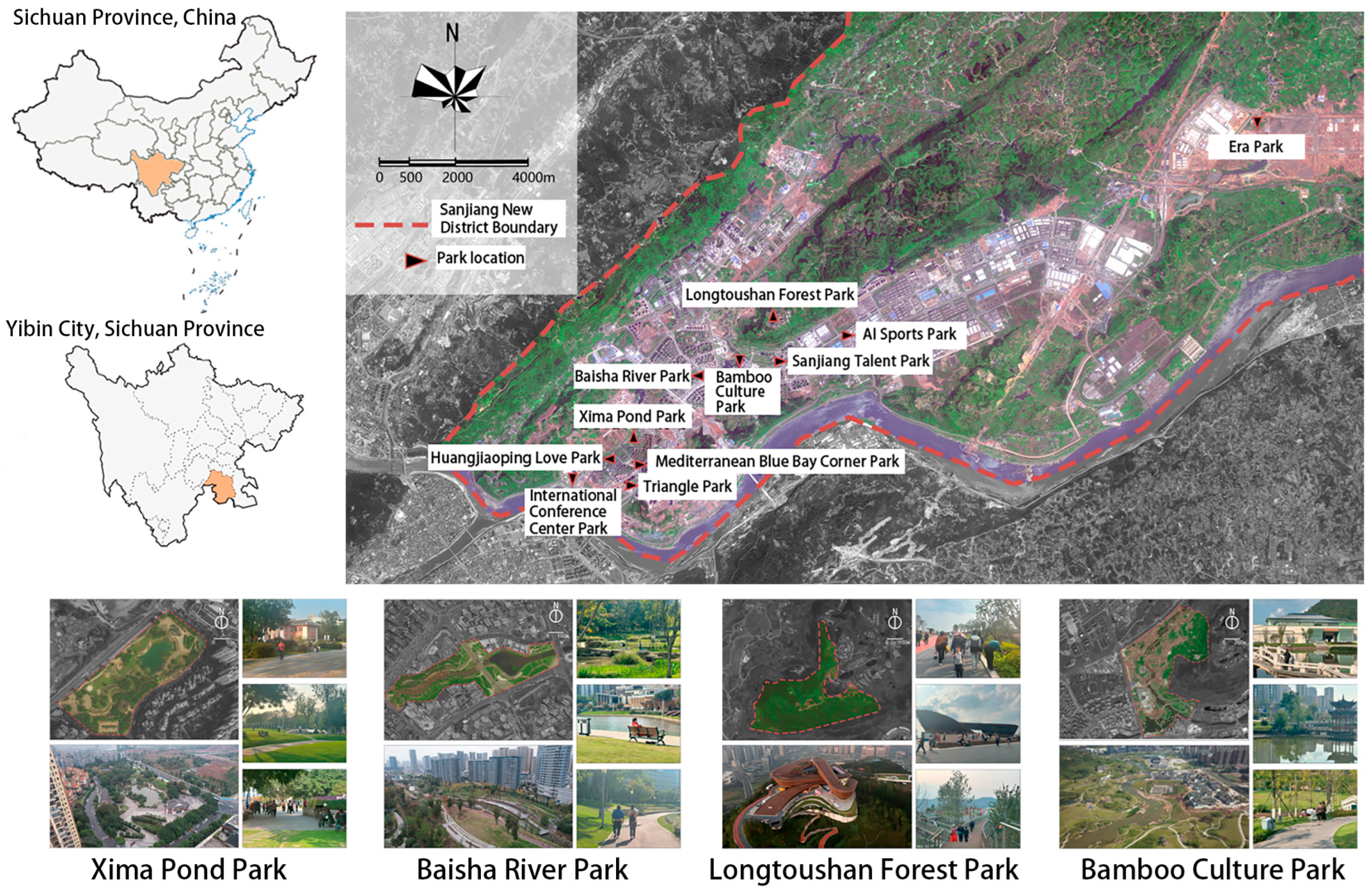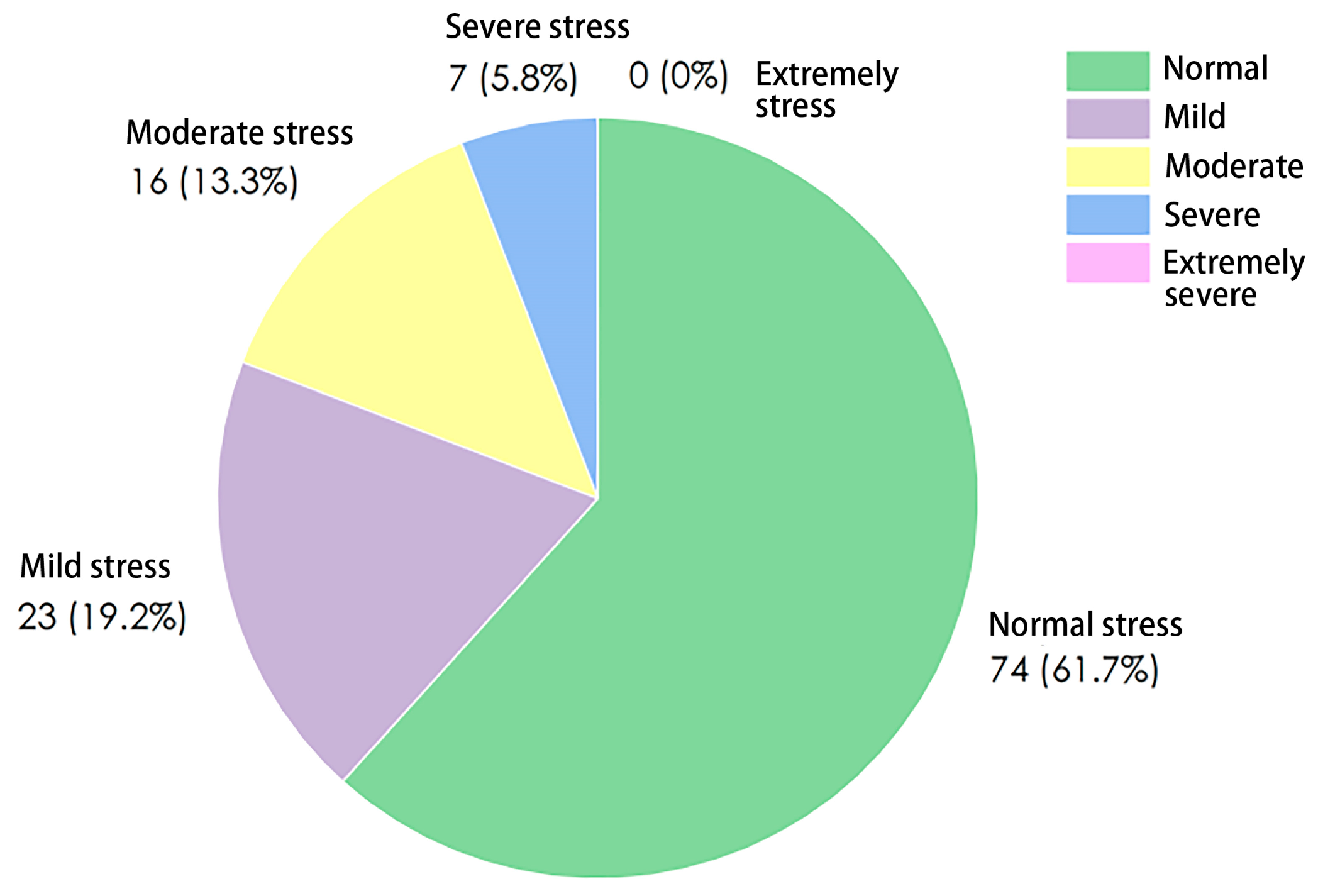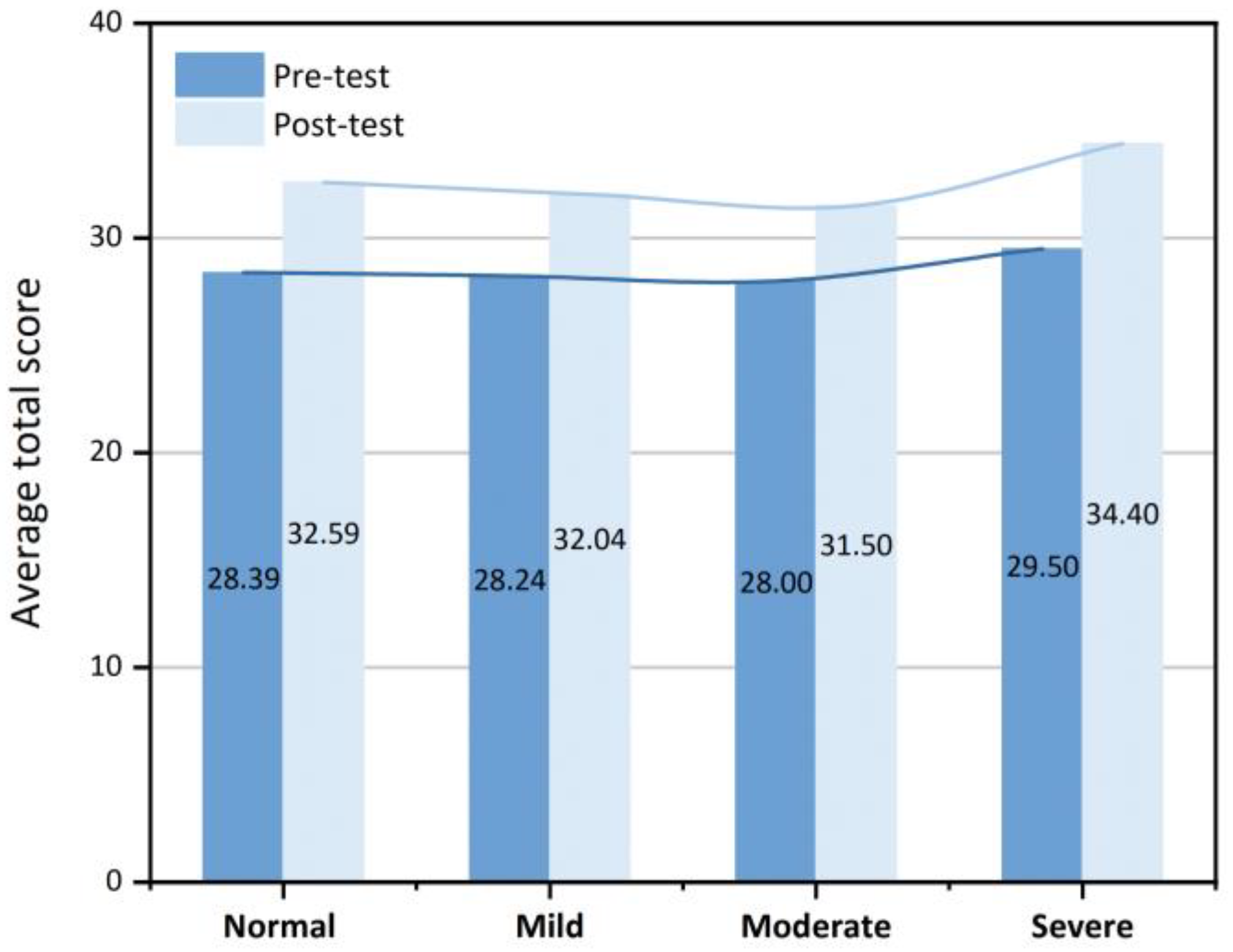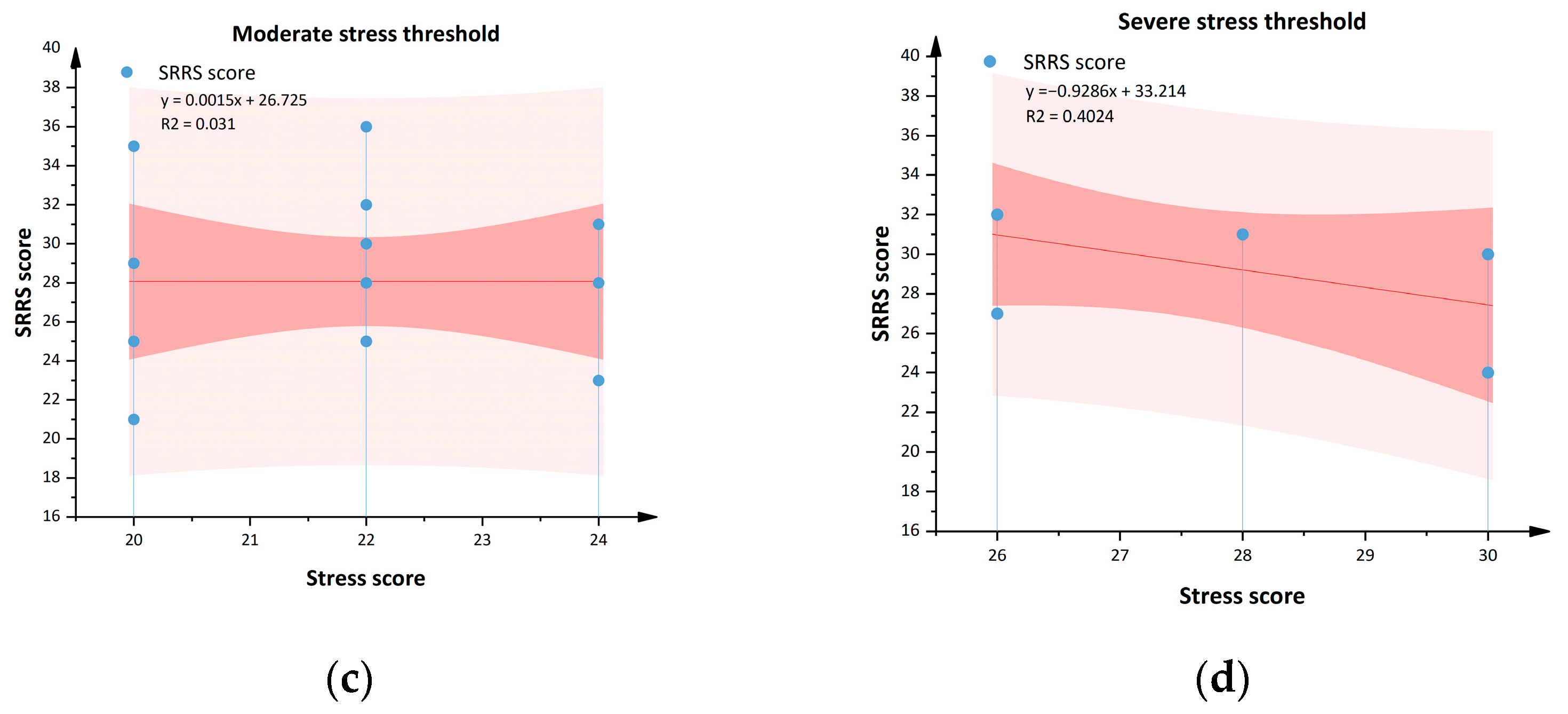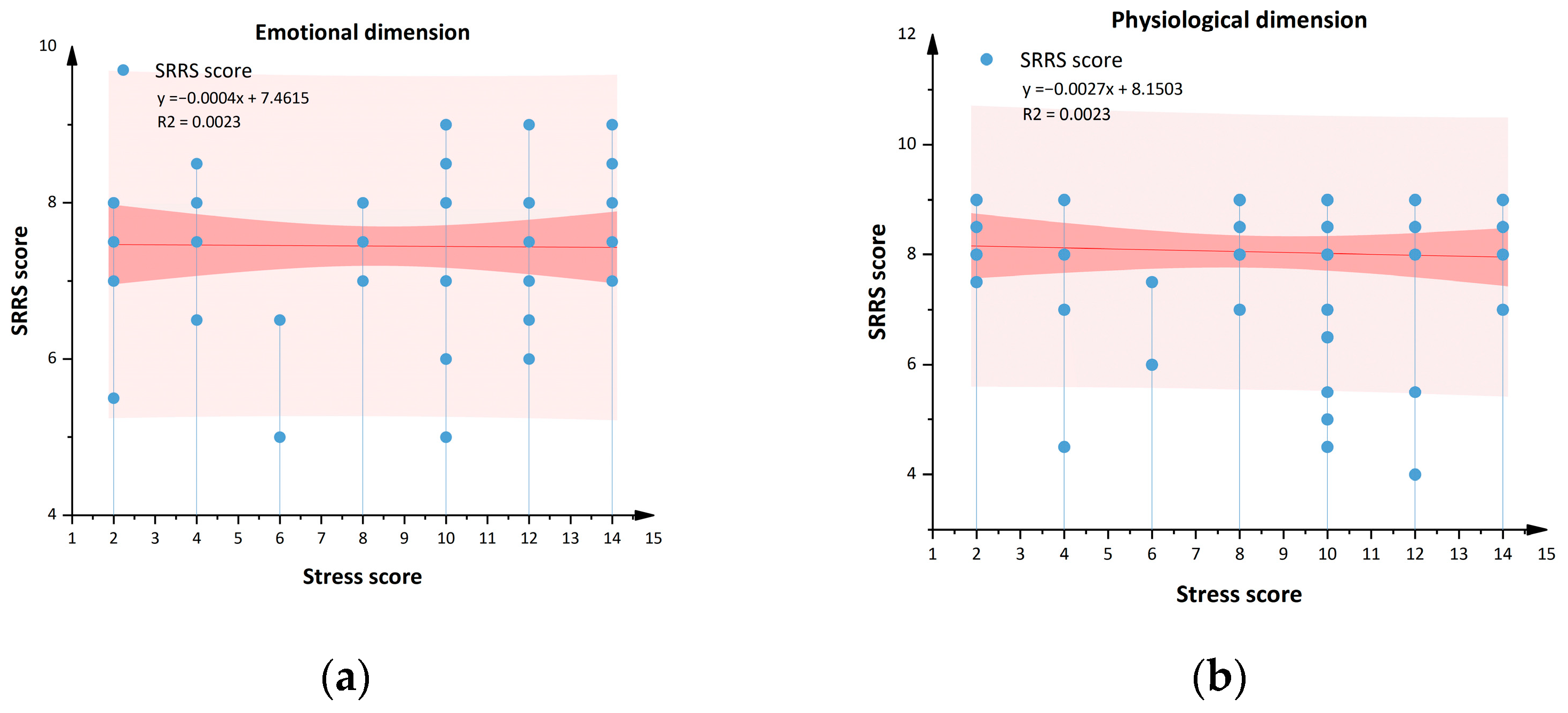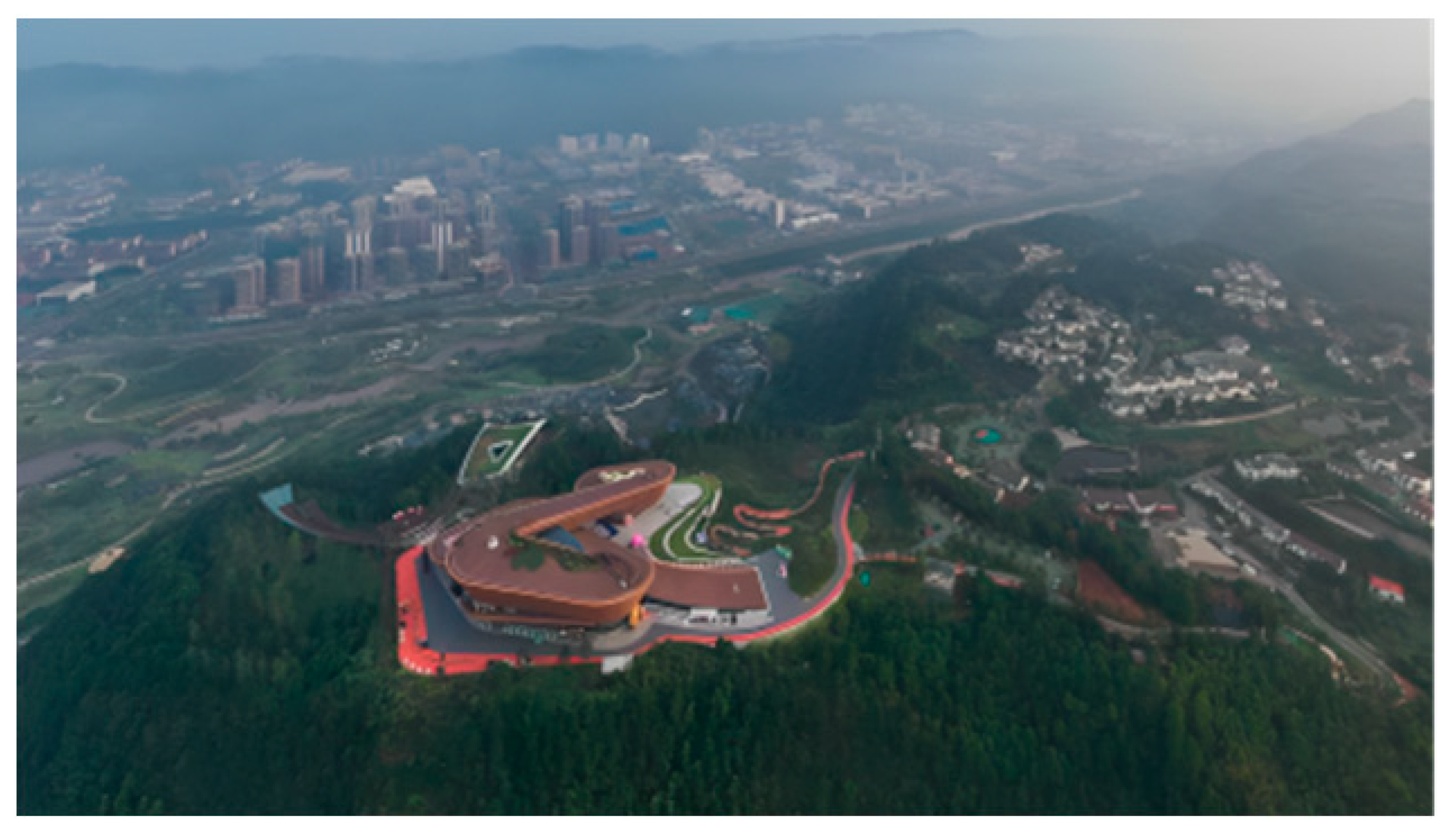3.1.1. Subjective Scale Results
- (1).
Self-assessment of recovery situation
A statistical analysis was conducted on the results of the self-rated restoration scale among the participants, as shown in
Figure 4.
Figure 4 displays the mean total scores on the self-rated restoration scale across four stress threshold groups, where higher scores indicate better environmental restorative benefits. The mean total scores on the self-rated restoration scale across stress threshold groups were as follows: Severe (29.5), Normal (28.39), Mild (28.24), and Moderate (28). This finding may suggest that individuals with varying stress levels perceive environmental restorative benefits differently. Paired t-tests revealed a significant increase in SRRS total scores from pre-test to post-test across all stress groups (all
p < 0.05), confirming the universal restorative benefit of park visits. Specifically, the normal stress group showed an average increase of 4.2 points (t = 5.32,
p < 0.001), the mild group 3.8 points (t = 4.87,
p < 0.001), the moderate group 3.5 points (t = 3.94,
p < 0.001), and the severe group 4.9 points (t = 4.12,
p = 0.006).
The stress threshold and self-rated restoration scale scores were subjected to Pearson correlation analysis in IBM SPSS 27 software, yielding the regression analysis results shown in
Figure 5.
As illustrated in the figure, within the normal stress threshold range (a), subjects’ restorative benefits show a slight increase, though this correlation is not statistically significant. In contrast, among individuals with mild to severe stress (b–d), a negative correlation emerges between stress level and restorative benefits: higher stress levels are associated with poorer restorative benefits. This suggests that the relationship between stress threshold and self-reported restoration scores may be more complex than anticipated, potentially moderated or mediated by latent variables such as individual psychological state, environmental design, or activity preferences.
The study further indicates that the restorative benefits of park green spaces are not determined by stress threshold alone, but rather result from multiple interacting factors. To explore this, self-reported restoration scores were categorized into four dimensions—emotional, physiological, cognitive, and behavioral—and subjected to regression analysis against the stress thresholds of the respective population groups.
- (2).
The four dimensions correspond to different changes in stress threshold awareness
To further explore whether there is a deeper underlying mechanism between stress threshold and self-rated restoration, a detailed statistical analysis was conducted on the participants’ self-rated restoration scale results. The data were categorized and analyzed across four dimensions: emotional, physiological, cognitive, and behavioral. The regression analysis results for different stress threshold groups are presented in
Figure 6,
Figure 7,
Figure 8 and
Figure 9.
Among individuals with normal stress thresholds, restorative effects showed no significant correlation at the emotional and physiological levels. However, a slight positive correlation was observed at the cognitive and behavioral levels. This suggests that the benefits gained by the normal stress group in park environments are primarily reflected in cognitive and behavioral aspects. Appropriate interaction with natural settings can enhance their subjective initiative, improve sensory cognition, and increase activity capacity.
Figure 7.
Mild stress threshold population 4-dimensional evenly distributed trend (Figure source: drawn by the author). (a) Trend of emotional dimension distribution. (b) Trend of ptysiological dimension distribution. (c) Trend of cognitive dimension distribution. (d) Trend of behavioral dimension distribution.
Figure 7.
Mild stress threshold population 4-dimensional evenly distributed trend (Figure source: drawn by the author). (a) Trend of emotional dimension distribution. (b) Trend of ptysiological dimension distribution. (c) Trend of cognitive dimension distribution. (d) Trend of behavioral dimension distribution.
Among the population with a mild stress threshold, a non-significant positive trend in restorative benefits was observed at the cognitive and behavioral level, while negative correlations appeared in the other dimensions. This suggests that for individuals with mild stress, the benefits gained maybe from park environments are primarily reflected in the behavioral domain. Specifically, appropriate outdoor interaction can enhance their activity capacity; however, it may also relate to negative impacts on their emotional and cognitive states.
Figure 8.
Moderate stress threshold population 4-dimensional evenly distributed trend (Figure source: drawn by the author). (a) Trend of emotional dimension distribution. (b) Trend of ptysiological dimension distribution. (c) Trend of cognitive dimension distribution. (d) Trend of behavioral dimension distribution.
Figure 8.
Moderate stress threshold population 4-dimensional evenly distributed trend (Figure source: drawn by the author). (a) Trend of emotional dimension distribution. (b) Trend of ptysiological dimension distribution. (c) Trend of cognitive dimension distribution. (d) Trend of behavioral dimension distribution.
Among the population with a moderate stress threshold, no significant correlation in restorative benefits was observed at the cognitive level, while a slight positive correlation appeared at the physiological level. Negative correlations were found in the emotional and behavioral dimensions. This indicates that for individuals with moderate stress, the benefits derived from park environments are mainly attributed to physiological stimulation.
Figure 9.
Severe stress threshold population 4-dimensional evenly distributed trend (Figure source: drawn by the author). (a) Trend of emotional dimension distribution. (b) Trend of ptysiological dimension distribution. (c) Trend of cognitive dimension distribution. (d) Trend of behavioral dimension distribution.
Figure 9.
Severe stress threshold population 4-dimensional evenly distributed trend (Figure source: drawn by the author). (a) Trend of emotional dimension distribution. (b) Trend of ptysiological dimension distribution. (c) Trend of cognitive dimension distribution. (d) Trend of behavioral dimension distribution.
Among individuals with a high stress threshold, restorative benefits exhibited a slight positive correlation at the physiological level, while negative correlations were observed across all other dimensions. These results indicate that although park environments may confer certain benefits to this population, individuals with excessively high stress levels should limit their duration of activity and engage in less complex or demanding tasks.
Although the severe stress group showed the highest total SRRS score, this may be driven primarily by heightened physiological sensitivity. In contrast, their emotional, cognitive, and behavioral restorative benefits decreased as stress levels increased, indicating a possible “decoupling” between physiological and psychological restoration under extreme stress.
A comprehensive analysis indicates that park-based green space activities exert significant stress-reduction and restorative environmental effects on participants. Across all stress threshold groups, this positive benefit was consistently observed, with participants generally experiencing stress relief and psychophysiological recovery following park activities. However, an in-depth analysis of recovery patterns within different stress threshold groups reveals critical differences: although individuals with normal to moderate stress levels showed relatively lower overall restorative benefits, their restorativeness—encompassing emotional, cognitive, behavioral, and physiological dimensions—demonstrated a slight upward trend with increasing stress levels, and negative effects were limited. In contrast, while individuals with high stress levels exhibited the highest overall recovery scores, their restorative benefits—particularly in emotional, cognitive, and behavioral domains—significantly decreased as stress levels increased. This finding highlights a marked divergence in recovery trends between the high-stress group and other stress threshold populations, suggesting that the benefits of park environments diminish as stress intensifies.
3.1.2. Environmental Awareness Capability
To explore the environmental awareness and behavioral activity preferences among different stress threshold groups, a correlation analysis was conducted on three influencing factors. After importing the environmental awareness and behavioral activity data into IBM SPSS 27 software, they were analyzed separately in relation to stress thresholds. The Pearson correlation test includes two indicators: a significance level of p < 0.05 indicates a significant correlation between the variables; the correlation coefficient determines the strength of the relationship. Generally, an absolute correlation value greater than 0.3 is considered to indicate a moderate or stronger correlation, while a value greater than 0.5 suggests a strong correlation. A positive value denotes a positive correlation, and a negative value indicates a negative correlation.
Correlation analysis between environmental awareness factors and stress threshold groups (
Table 3) indicates that most environmental factors are significantly associated with specific stress levels, with varying correlation directions. Key findings include:
Plant color was weakly positively correlated with mild stress (r = 0.249).
Plant variety showed weak positive correlations with mild (r = 0.285) and moderate stress (r = 0.185).
Plant scent exhibited a weak negative correlation with normal stress (r = −0.200).
Plant layering was moderately positively correlated with mild (r = 0.233), moderate (r = 0.352), and severe stress (r = 0.365).
Water landscape appreciation was weakly positively correlated with mild (r = 0.303) and moderate stress (r = 0.243).
Terrain form showed a weak positive correlation with severe stress (r = 0.192).
Rest facility comfort was weakly negatively correlated with normal (r = −0.211) and severe stress (r = −0.205).
Paving comfort had a weak negative correlation with normal stress (r = −0.192), but weak positive correlations with mild (r = 0.254) and moderate stress (r = 0.239).
Several factors—including architectural aesthetics, building quantity, rest facility landscape orientation, path guidance, activity space area, and the number and variety of fitness and recreational facilities—showed no significant linear correlations with any stress threshold (p > 0.05). However, this does not preclude the possibility of nonlinear relationships, which warrant further investigation.
Overall, the associations between environmental awareness factors and stress levels are complex, including both positive and negative correlations, and vary by stress severity. Some factors are only correlated with specific stress levels. Although certain variables did not show significant linear associations, their potential nonlinear or interactive effects merit deeper exploration in future research.
3.1.3. Preference for Behavioral Activities
Correlation analysis between types of behavioral activities and stress threshold groups (
Table 4) indicates that most behavioral activity dimensions do not exhibit significant linear correlations with stress levels (
p > 0.05), though nonlinear or interactive effects cannot be ruled out. Specific findings include:
Relaxation and reflection showed a weak positive correlation with mild stress (r = 0.198).
Nature contact and social interaction had no significant linear correlations with any stress threshold group (p > 0.05).
Free activities exhibited a weak negative correlation with severe stress (r = −0.221).
Facility-based activities and site-based activities were not significantly correlated with any stress threshold group (p > 0.05).
Walking was weakly positively correlated with moderate stress (r = 0.245).
Running showed a weak negative correlation with normal stress (r = −0.203).
Cycling had no significant linear correlation with any stress threshold group (p > 0.05).
In summary, only a few significant linear correlations were observed between behavioral activities and stress thresholds, with varying directions depending on the activity type and stress level. This suggests that complex, nonlinear relationships may exist between specific park behaviors and the restorative benefits experienced by individuals with different stress levels, warranting further investigation.



